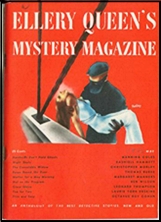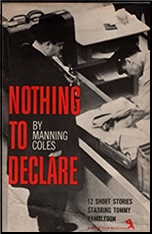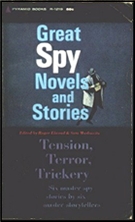Tue 20 Jul 2021
Stories I’m Reading: MANNING COLES “Handcuffs Don’t Hold Ghosts.â€
Posted by Steve under Stories I'm Reading[3] Comments

MANNING COLES “Handcuffs Don’t Hold Ghosts.†Novelette. Tommy Hambledon. First published in Ellery Queen’s Mystery Magazine, May 1946. Collected in Nothing to Declare (Doubleday, 1960). Reprinted in The Saint Mystery Magazine, January 1964. Also reprinted in Great Spy Novels and Stories, edited by Roger Elwood & Sam Moscowitz (Pyramid, paperback, August 1965).
I don’t remember the title, but one of intrepid British agent Tommy Hambledon’s adventures was one of the first “grown up†mysteries I remember reading. (It was in one of the Detective Book Club’s 3-in-1 volumes I checked out of the local library, circa 1956.) It was a strange exciting affair, and all I remember of it was its very remarkable ending, one that came as a complete surprise to me, having (I think) something to do with an identity kept secret all through the book.
I’ve been a fan ever since.

As time went on, I began to appreciate the serio-comic approach the Coles’ took to spy fiction all the more. Hambledon’s adventures are deadly serious, but sometimes he does get into the darnedest situations!
“Handcuffs Don’t Hold Ghosts†starts out in truly superb fashion, which means it can only go down from there, but there’s a last couple of paragraphs that completely makes up for any sag that comes in the middle section. Hambledon and his good friend Chief Inspector Bagshot are listening to the radio, logs on the fire, and in particular a presentation by the BBC being a live production of two psychic investigators looking for ghosts in an old *haunted* mansion. First, under very spooky situations, one of the investigators disappears, then the other, following by the announcer, then the two radio technicians who come in to see what’s going on. All on live radio.
Brrr.

Turns out that Tommy knows the owner of the house, and the next day he and Bagshot go in person to investigate. Tommy also knows more about the old fellow than he lets on, so there’s no attempt to make this a fair play mystery. It’s more of a thriller than a detective story, but as I said there up above, the last couple of paragraphs more than make up for any letdown after that totally fabulous opening.
What’s really going on, I can’t tell you, but I may as well give you a hint, along with the obligatory [WARNING!]. The story first appeared in 1946, soon after the war ended, and people in Britain especially were still wondering what was happening to all of the Nazis, especially those at the top echelon, some of whom were captured and others were not.
If that’s too much of a hint, I apologize.
July 20th, 2021 at 8:59 pm
This one is classic Coles and Hambledon who I’ve always thought has something of the vibe of John Steed and Mrs. Peel to his adventures if Steed had been played as by John Mills or Richard Attenborogh.
The first Hambledon I ever read impressed me because at the end of a threat of a lost nuclear weapon, a plot I had read a million times, Hambledon solves the problem of recovering it by letting it go off in the deep jungle and take out the dangerous people who have gotten ahold of it. Just finding a way to let the nuke go off and not impact the rest of the world too much was enough to grab my twelve year old imagination.
That strange mix of detective fiction, serious spy fiction, Ealing style comedy, and even slapstick that mark the Coles books worth reading is hard to convey to anyway who hasn’t read them.
The Coles have been revived recently in ebook form at reasonable prices and it is nice to see them available again.
July 21st, 2021 at 1:46 pm
Something of the vibe of Steed and Peel… I can see why you say that, but I think they and the Hambeldon stories are each unique in their own special way. I’ve never been able to put into words the real essence of the Coles books. As you suggest, a concept nearly impossible to convey to those who haven’t read them.
July 21st, 2021 at 7:27 pm
It;s almost impossible to explain the Hambledon books to anyone who hasn’t read them. Hambledon is as smart as Smiley, as capable as Quiller, lethal as Bond, and as off the wall as Gervase Fen. The male half of the writing team was an actual agent and the tradecraft is genuine, but the series never becomes bogged down in mere realism. I can only say of Hambledon and the Coles that the experience is as you say unique.